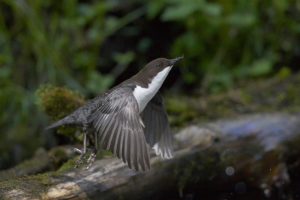Looking into the maelstrom of an upland stream, our eyes go white-water rafting over the rapids and our ears are overwhelmed by a roaring, hissing torrent. Even though our senses are drowned, our attention is grabbed by a diminutive figure on its little boulder of a stage – a bob, a curtsey, the up and down flash of a white-breasted bird, a wren-like cock of the tail. Britain has its share of tail-wagging, head-flicking birds, but nothing dips quite like a dipper. Each dip is accompanied by a blink of its eye, the white-feathered eyelid winking like an indicator light. We can’t help having our heads turned by these repetitive gestures.
Many scientists offer the slightly unnerving thought that the dipper wants you to see it. In dipper-meets-dipper situations, the dip is a show of strength, a kind of ‘look how many bench presses I can do’. It draws the opposite sex, and it warns off a rival. And this is a display meant for others with more deadly intent. Just as a hare will stand up before a fox to let it know it’s been spotted, so the dipper dips to the binocular-clad figure on the bank. It’s as if it’s saying I’ve clocked you, so don’t think you can catch me. If only things were this straightforward. An alternative theory for the dipper’s shtick argues the exact opposite. Both the dipper and the grey wagtail, with its erratic tail-bobbing, are – so the theory goes – making movements to blend in with the turbulence of their environment. A predator might spot an object that stays still, but cannot easily pinpoint it in a whole scene of permanent flux.
So just why does the dipper dip? It sounds like a joke and perhaps the joke is on us. Stephanie Tyler has studied dippers intensively for 40 years, longer than anyone else on the planet. She has watched all five species of this remarkable family, from the Himalayas to the Rocky Mountains and the rivers of South America. Every one of them dips. What’s her conclusion? “It is the question I am asked more than any other. Everybody always asks me why they do it and there are all sorts of hypotheses, but nothing is really definite.” For all its fancy and, it seems, inexplicable dance moves, we name the dipper after one of its less impressive characteristics. There is far more to shout about when it leaps offstage: the real magic happens below the water’s surface. The dipper looks an unlikely candidate for the claim to be ‘Britain’s only aquatic songbird’. It stands on its rock looking not so much like a streamlined submariner as an overfed blackbird, and it’s about the same size. However, freshwater biologist Steve Ormerod has worked on this species for 34 years and declares: “Dippers are just the most fantastically adapted organisms.”

Some of these adaptations are invisible. The bird has unusually high haemoglobin levels in its blood, enabling it to store large amounts of oxygen on underwater dives. A special flap seals its nose from inrushing water, and it has exceptionally well-developed muscles that control the shape of its lenses, helping it to surmount the visual difficulties of refraction in water. Other adaptations can be felt by a scientist who has handled thousands of dippers in his career. Short but strong flipper-like wings beat the bird down to the bottom and then long toes with powerful claws act like crampons as it walks along on the stony river bed: “Those claws grip incredibly tightly, they squeeze very, very hard,” comments Ormerod, from uncomfortable experience.














